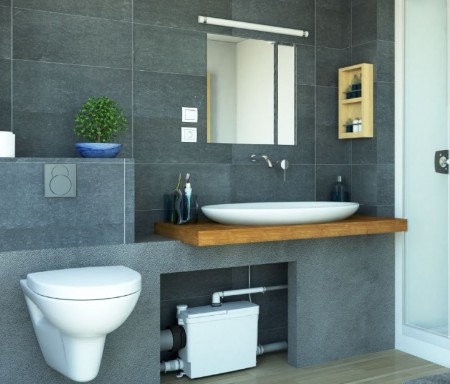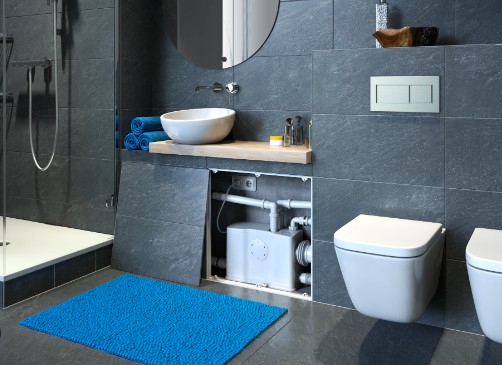Are you experiencing macerator toilet problems? Dealing with such issues can be highly frustrating, considering they differ from standard toilets.
The most common problems you may face with a macerating unit include the toilet not holding water or not working at all. In addition, you may find your toilet leaking and unable to drain efficiently. The macerator pump could also operate without input and even trip the electrics.
This post explores macerator toilet problems and their causes and gives practical solutions.

Macerator Toilet Problems (Causes & Recommended Solutions)
| Problem | Cause | Recommended Solution | |
| 1. | Toilet leaking | Faulty/clogged vent Drooping macerator pump outlet Internal seal failure Loose external connections | Tighten exterior connections Call a plumber |
| 2. | Toilet not working | Clogged waste pipe Blocked internal mechanism Improper installation of outflow pipes | Clear the clog Call a plumber |
| 3. | Foul smell | A buildup of human waste and limescale | Deep regular cleaning |
| 4. | Toilet not flushing | Insufficient air compression Faulty rubber membrane Clogged waste outlet pipe Faulty return valves Defective microswitch | Check the airflow pipes Replace the rubber membrane Clear the clog Replace the valves Replace the macerator toilet |
| 5. | Toilet not draining | Blades trapping foreign materials | Avoid dumping non-flushable items in the toilet |
| 6. | Pump starts on its own | Faulty microswitch | Replace the toilet |
| 7. | Toilet tripping electrics | Water in the circuit | Call a professional |
1. Toilet Leaking
One common macerator toilet problem you may encounter is the toilet not holding water, as the manufacturers promised. Instead of maintaining the usual water level, you might notice it only has three inches in the bowl.
The problem can stem from a drooping macerator pump outlet that causes water to seep out rather than remain inside the bowl. You can tell from reducing water levels.
Another cause could be a faulty or clogged vent, which disrupts the proper airflow and prevents water from staying in the toilet bowl. Plumbers also advise checking internal seal failure and external leaks as potential culprits in this menace.
Despite the inconvenience, your toilet will flush normally; but inadequate water levels can lead to hygiene concerns and unpleasant odors.
Fix
- Start by pressing the flush pedal to release the half-ball then dip your hand into the bowl to pull up and remove the seal.
- Use Dawn dish soap or any other gentle cleaner to clean the internal seal. After that, soften and make the seal malleable by soaking it in water for five minutes.
- Next, close the half-ball, and with your finger as a guide, position the seal in the toilet bowl area.
- Carefully press the half-ball to secure it underneath the inner rim.
- If you have external leaks, tighten the connections.
2. Toilet Not Working
A macerator toilet not working is inconvenient and frustrating at the same time. The good news is that you can identify the source of the problem.
One typical cause of a non-functioning macerator toilet is a clogged waste pipe. Solid waste, debris, toilet paper, and other foreign materials accumulate and block the macerator system.
Therefore, a dysfunctional macerator can arise from a blocked internal mechanism. As you may know, the unit employs blades to grind the waste into smaller portions that can flow seamlessly through the sewer system.
Flushing foreign materials into the toilet interferes with the disintegration of waste, discounting the fixture’s flushing capabilities.
Moreover, the improper installation also contributes to your macerator not working. For instance, plumbers might have installed the waste pipe, leaving your pump at 90 degrees or failing to align the macerator unit to the toilet bowl.
Fix
- Use a plumbing snake or plunger to unclog the toilet.
- Clean or replace obstructed internal components.
- Ensure proper installation to restore the functionality of your unit.
- If you are unsure about DIY, seek professional help.
3. Foul Smell
An unpleasant smell from your macerator toilet into breathable air in the adjacent areas causes untold discomfort. It is more embarrassing when you host friends or guests in your apartment.
The primary cause of the foul smell is the buildup of human waste within your macerator toilet system. The waste materials accumulate in the pipes and other components; if left unattended, they’ll create a breeding ground for bacteria.
The bacteria decompose human waste and release foul-smelling gases into the bathroom.
Apart from human waste, the accumulation of limescale in your toilet will have the same effect. Limescale is a hard, chalky coating that forms on the internal surface of the macerator unit when water evaporates.
Therefore, this problem requires immediate resolution to avert discomfort.
Fix
- Do regular cleaning and maintenance using bleach and a descaler.
- Alternatively, follow the manufacturer’s cleaning instructions to disinfect your unit.

4. Toilet Not Flushing
A macerator toilet that won’t flush makes your bathroom unsightly, and you may need a bucket of water to whisk waste away. But what would cause your unit not to flush?
Firstly, a clogged waste outlet pipe or macerator can impede the flow of waste. Foreign objects obstruct the waste pipe, cutting down the macerator’s ability to grind and expel waste effectively.
Insufficient air compression is another reason your macerator toilet might not be flushing. The system relies on compressed air to create the necessary pressure for waste expulsion.
Inadequate air compression occurs due to air leaks or a malfunctioning air compressor.
Moreover, your macerator toilet not flushing can arise from a faulty rubber membrane. The rubber membrane closes the space between the macerator pump and the waste chamber to prevent water from flowing back after flushing.
If the rubber membrane deteriorates, it will give up its sealing ability. It can lead to incomplete flushing and, in a worst-case scenario, not flushing.
Additionally, faulty return valves can affect your macerator toilet’s flushing performance. The valves regulate the flow of water and waste in the system.
So when the valves malfunction, they fail to open and close properly, leading to inadequate flushing. You can also examine the unit for a faulty microswitch and blown capacitor or motor.
Fix
- Start by turning off the bathroom breaker and try restarting it then inspect and clear the air pipe and the macerator.
- Check the macerator system for leaks.
- Inspect the rubber membrane and replace it if it’s damaged. After that, clean and maintain the return valves regularly.
5. Toilet Not Draining
When it comes to a macerator toilet, one issue you may confront is the unit’s failure to drain. It stems from different factors, some of which have multiple causes.
One place to look at is whether the macerator blades caught foreign materials. Over time, items like sanitary pads or excessive toilet tissue get caught in the toilet blades and impede drainage.
A damaged rubber membrane is another cause of improper drainage in a macerator toilet. If the rubber membrane wears out or becomes damaged, it causes leaks and ultimately slows the drainage process.
Just like the toilet not flushing problem, faulty return valves also compound drainage problems in your unit. When the return valves malfunction, they prevent the seamless effluent flow from the system.
Furthermore, improper installation and poor drainage can cause to this issue.
Fix
- Experts advise you to start by putting on appropriate protective gear to avoid touching solid human waste.
- Switch off the power supply to the macerator unit then find the lever and push it towards the backside of the toilet tank. This stops the water flow.
- Flush the toilet to drain water from the bowl and place a bucket underneath the pipe connected to the top of the unit.
- Loosen the pipes using a wrench to allow the remaining water to pour into the bucket.
- Next, unplug the pipes and use warm water to clear blockages within the plumbing system. Alternatively, use a plumbing snake.
- Undo the screws from the toilet base and squeeze the ends of the connector’s metal clip.
- Detach the macerator from behind the toilet while cleaning the water spills.
- Check the connection at the backside of your toilet for clogs. If it has a blockage, use warm water to flush it.
- Reinstall the pipes and the toilet then reconnect the water supply and electricity to the macerator toilet system.
6. Pump Starts On Its Own
Another infuriating issue you may face after installing a macerator toilet is the pump operating without input from you. The unexpected activation can lead to disruptive noise and unnecessary wear and tear on the mechanism.
If you have a macerator pump that doesn’t wait for your intervention to run, then chances are you have a damaged rubber membrane. When this component deteriorates, it loses its ability to provide a proper seal.
Consequently, the pump would function randomly because air pressure will trigger its operation.
Besides a damaged rubber membrane, a faulty microswitch is another area worth investigating. It is a device that detects water levels in the system and signals the pump to activate when necessary.
If the component malfunctions, it can send the wrong signals to the pump, causing it to start unexpectedly. A typical problem with the microswitch is when it gets stuck in the “ON” position, constantly signaling the pump to run.
Fix
- Replace the microswitch and the rubber membrane.

7. Toilet Tripping The Electrics
If your macerator toilet trips your electricity constantly, you are looking at a bigger problem than you realize. It is because of the risks tripping electrics poses.
The problem stems from water splashing into the electric circuit. You can also trace it to a leak within the toilet system that provides loopholes for water to seep into the electrical components.
On top of that, a faulty motor is not something to overlook. Such malfunctioned devices can draw excessive electrical current, resulting in tripping.
Fix
- Contact a certified expert to put a new macerator in place.
Concluding Thoughts On Macerator Toilet Problems
Macerator toilets can be an excellent addition to any restroom, especially since they work in areas gravity-fed toilets aren’t feasible. However, you should know how to handle the problems that may arise when using them.
Thankfully, this post has highlighted problems to expect and the solutions to implement. If in doubt, seek professional help since they are better equipped to handle various issues.
Related Posts:
